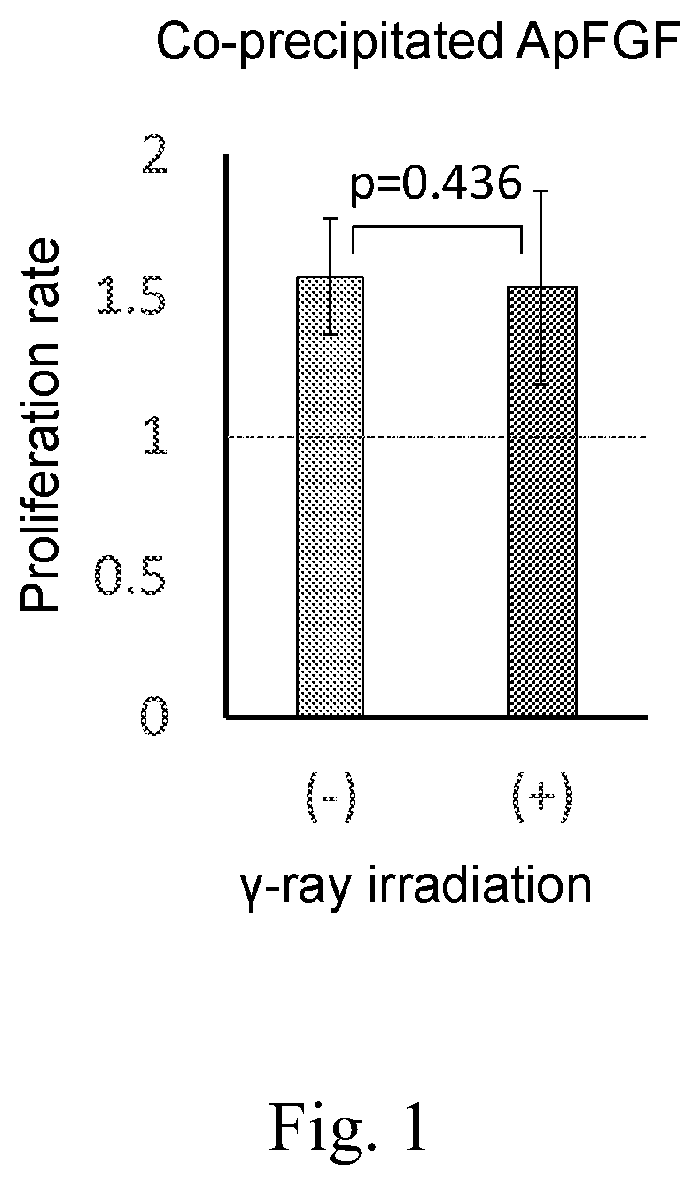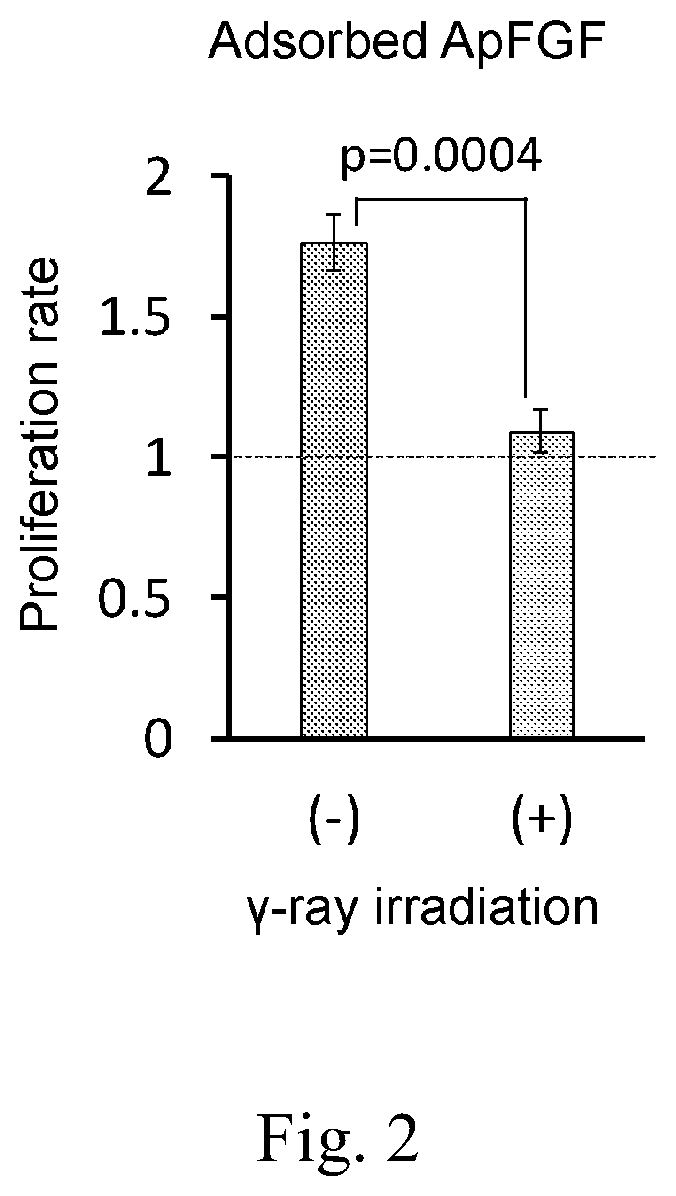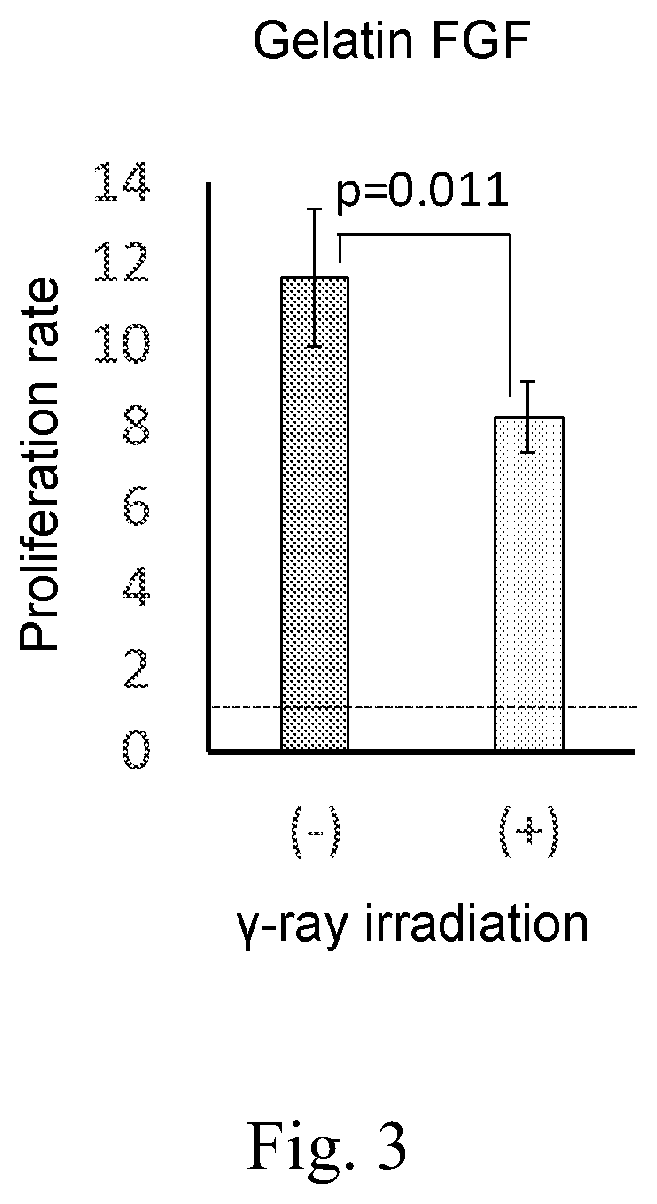Inorganic salt-protein composite medical instrument
- Summary
- Abstract
- Description
- Claims
- Application Information
AI Technical Summary
Benefits of technology
Problems solved by technology
Method used
Image
Examples
example 1
Cell Proliferation Activity after Radiation Sterilization of External Fixation Pin Coated with Apatite into which FGF-2 was Embedded
[0185]A titanium pin for intracorporeal fixation, which may be used for fracture fixation, was coated with an inorganic salt solid into which FGF-2 having cell proliferation activity was embedded, the resultant was entirely subjected to ionizing radiation sterilization, and thereafter whether or not FGF-2 had cell proliferation activity was examined.
[0186]An unstable supersaturated calcium phosphate solution including 4.89 mM of Ca ion, 1.28 mM of phosphate ion, 6.13 mM of K ion, 138.8 mM of Na ion, 0.23 mM of Mg ion, 136.6 mM of Cl ion, and 15.09 mM of HCO3 ion, and having a pH of 7.8, in which calcium phosphate would be crystallized by spontaneous nucleation in about 4 to 5 hours if the solution was left at 37° C. as it was, was used (this unstable supersaturated calcium phosphate solution was different from the liquid of Patent Document 19). Fibrobla...
example 2
Cell Proliferation Activity after Radiation Sterilization of External Fixation Pin Coated with Apatite to which FGF-2 was Adsorbed
[0190]Titanium pins for intracorporeal fixation, which may be used for fracture fixation, were coated with an inorganic salt solid to which FGF-2 having cell proliferation activity was adsorbed, the resultants were entirely subjected to ionizing radiation sterilization, and thereafter whether or not FGF-2 had cell proliferation activity was examined.
[0191]An FGF-2-free supersaturated calcium phosphate solution was prepared using the same unstable supersaturated calcium phosphate solution as in Example 1, and 6 or 8 titanium pins for intracorporeal fixation (DePuy Synthes, cell drill 4.0 / 3.0 mm Ti, 20 mm-80 mm) were immersed therein at 37° C. for 48 hours, to thereby produce respective Ap pins whose surfaces were coated with apatite. The Ap pins were immersed in a supersaturated calcium phosphate solution containing 12 μg / ml of FGF-2 for several seconds, a...
example 3
Cell Proliferation Activity after Radiation Sterilization of External Fixation Pin Coated with Gelatin into which FGF-2 was Embedded
[0194]The titanium pins for intracorporeal fixation, as with in Example 1, were immersed in a 1% gelatin solution containing 4 μg / ml of FGF-2 for several seconds, and frozen at −18° C., to thereby produce pins (gelatin FGF) coated with gelatin into which FGF-2 was embedded. The pins were vacuum-dried at room temperature, subjected to or not subjected to γ-ray irradiation, stored, and evaluated with respect to cell proliferation activity, in the completely same conditions as in Example 1. An operation including coating with gelatin into which FGF-2 was embedded, γ-ray irradiation or no γ-ray irradiation, and measurement of the proliferation rate was repeatedly trialed four times.
[0195]Table 3 shows the number of gelatin FGF pins rated as “having activity” in the four repeated trials. FIG. 3 illustrates the values of the proliferation rates measured.
TABLE...
PUM
| Property | Measurement | Unit |
|---|---|---|
| Irradiation dose | aaaaa | aaaaa |
| Irradiation dose | aaaaa | aaaaa |
Abstract
Description
Claims
Application Information
 Login to View More
Login to View More - R&D Engineer
- R&D Manager
- IP Professional
- Industry Leading Data Capabilities
- Powerful AI technology
- Patent DNA Extraction
Browse by: Latest US Patents, China's latest patents, Technical Efficacy Thesaurus, Application Domain, Technology Topic, Popular Technical Reports.
© 2024 PatSnap. All rights reserved.Legal|Privacy policy|Modern Slavery Act Transparency Statement|Sitemap|About US| Contact US: help@patsnap.com










